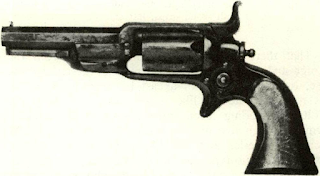One of the most ingenious revolvers of the South,
Perhaps it was after Cofer blew up his first model,
An exceptionally fine Cofer percussion model with
Six shot, .36 caliber, cylinder length l3A inches with six
That there may be some connection between the
e. b. georgia has a Whitney lever. “Why?” is one
The blown-up Cofer has checkered grips; No. 1
Perhaps it was after Cofer blew up his first model,
An exceptionally fine Cofer percussion model with
Six shot, .36 caliber, cylinder length l3A inches with six
 |
| Sidehammer, Colt, .31 cal. revolver, No. 400 was |
That there may be some connection between the
e. b. georgia has a Whitney lever. “Why?” is one
The blown-up Cofer has checkered grips; No. 1

Comments
Post a Comment